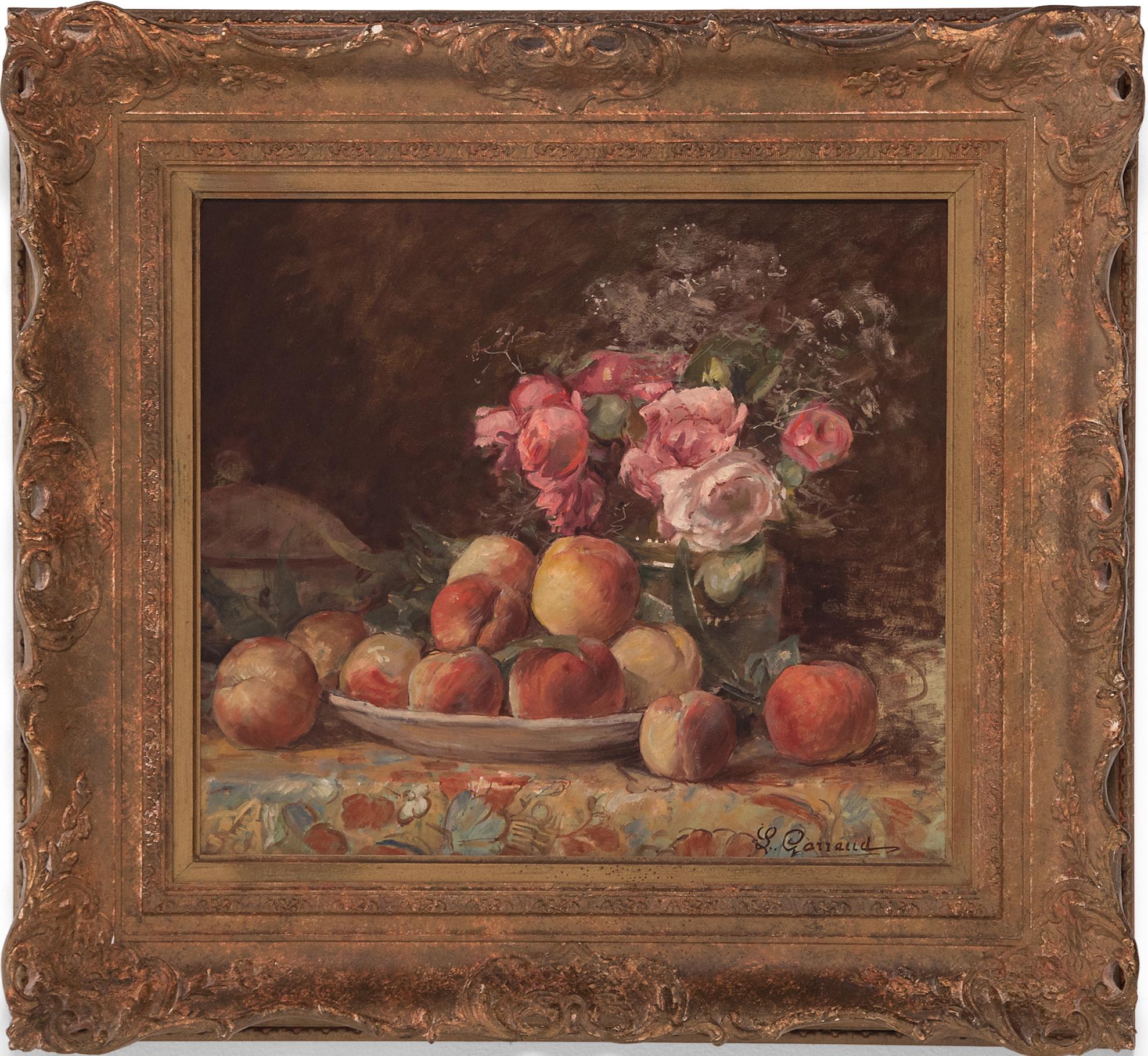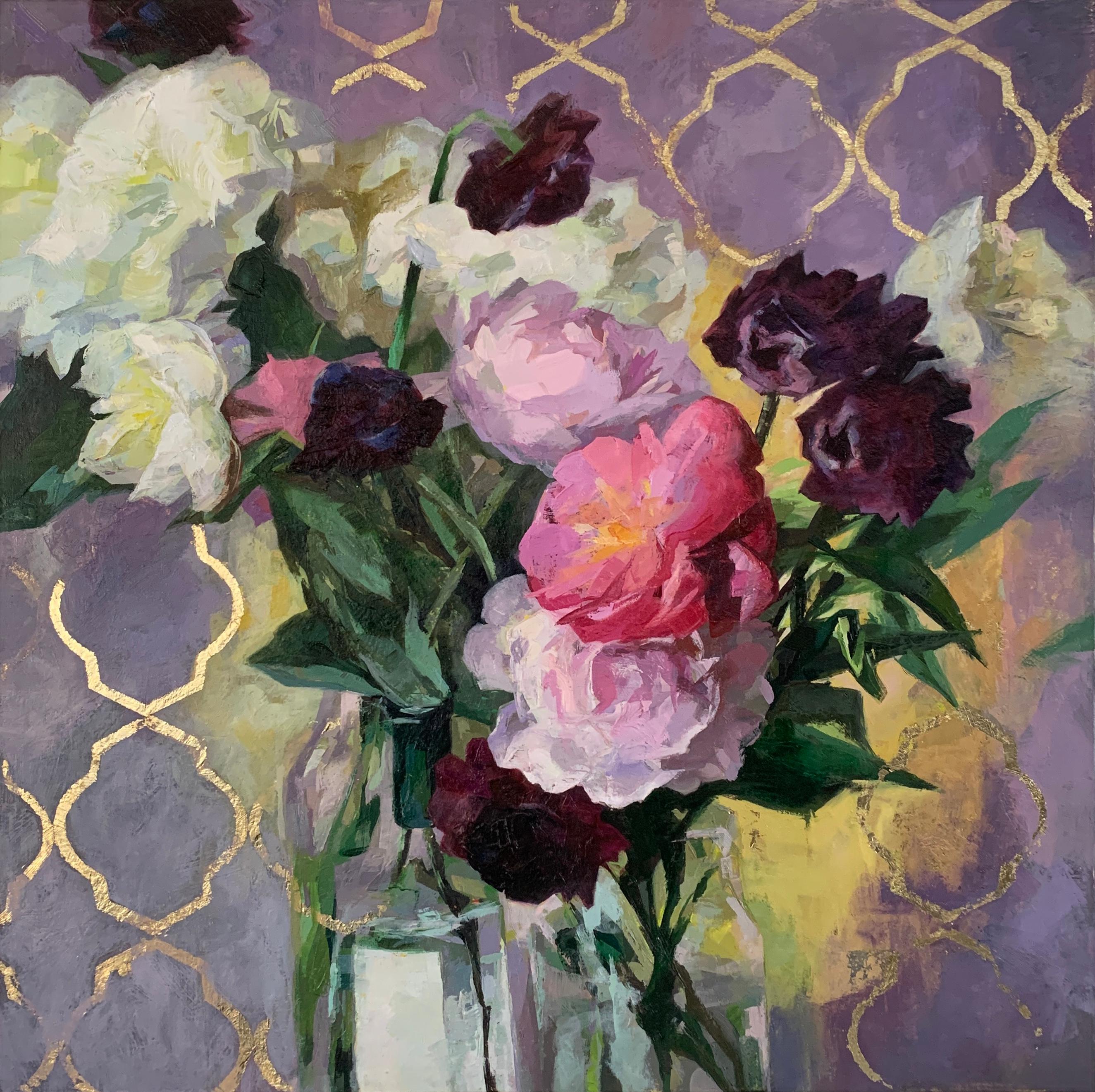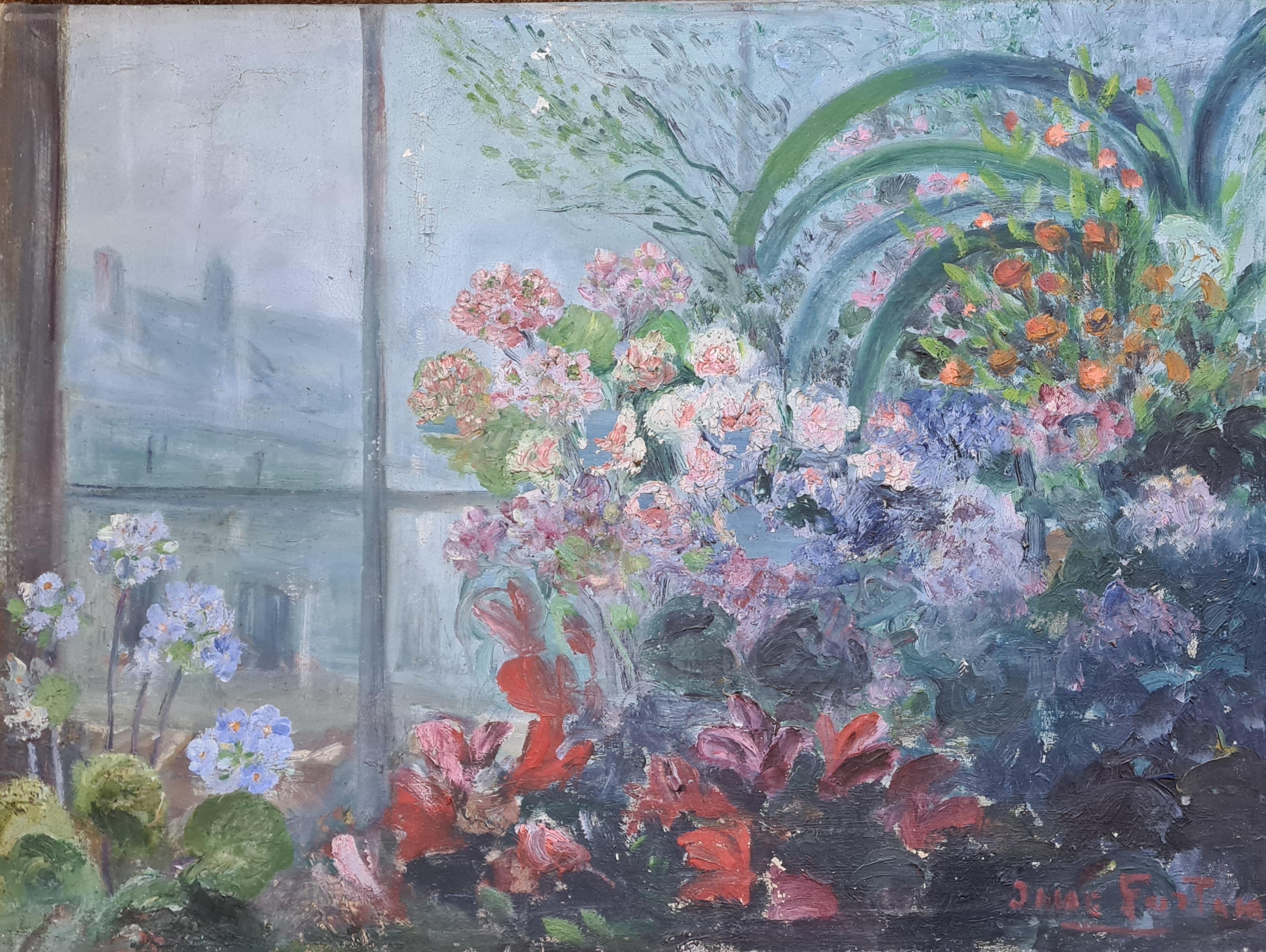Items Similar to Fleurs au pot de gres rose - Fauvist Still Life Oil Painting by Charles Camoin
Want more images or videos?
Request additional images or videos from the seller
1 of 16
Charles CamoinFleurs au pot de gres rose - Fauvist Still Life Oil Painting by Charles Camoin 1928
1928
About the Item
Signed still life oil on canvas by French expressionist and fauvist painter Charles Camoin. The work depicts a bright bouquet of flowers in reds, yellows, blues and pinks in a stoneware vase.
Signature:
Signed lower right
Dimensions:
Framed: 36"x28"
Unframed: 29"x21"
Provenance:
Galerie Marcel Bernheim
Exhibitied: Paris, Galerie Druet, March 1929, n°23
This work is included in the Archives Camoin and a certificate from Madame Grammont-Camoin is available on request
Charles Camoin was the son of a paint manufacturer in Marseilles who died when Charles was six years old. His mother travelled extensively, absenting herself for long periods at a time, and Camoin's studies suffered accordingly. At 16, he enrolled at a commercial college in Marseilles, but also attended courses at the École des Beaux-Arts, where he was awarded a first prize for drawing and composition. In 1896, at the age of 17 (or in 1898 according to other, possibly more reliable sources), Camoin moved to Paris where he was admitted to Gustave Moreau's class at the École des Beaux-Arts, shortly before the latter's death. He soon left on his travels in the company of Albert Marquet - no doubt following Moreau's advice to 'go and paint buses', his recommendation to the two artists to search out their subject matter on the streets and in the cabarets of Paris. During his short time in Moreau's class Camoin made a number of lasting friendships, notably with artists who would go on to pioneer Fauvism: Henry Manguin, Georges Roualt and, in particular, Jean Puy and Henri Matisse, with whom he exchanged letters on a regular basis.In 1900, Camoin did his military service, first in Arles, where he painted compositions inspired by Van Gogh motifs, then in 1902 in Aix, where he frequently met with Cézanne, with whom Camoin maintained a life-long correspondence and whose advice and counsel he cited repeatedly. In 1903, Camoin exhibited for the first time - at the Salon des Artistes Indépendants in Paris. The following year (1905), he met Claude Monet (at Cézanne's instigation and, appropriately perhaps, underneath Giverny's Nympheas); he then held his first solo exhibition at the Berthe Weill Gallery in Paris. In 1905, Camoin exhibited alongside the 'Animals' at that year's Salon d'Automne, although it must be said that he did not share the graphic and chromatic violence of a Matisse or a Derain, preferring as he did to adhere to a more Cézanne-like approach.
The following decade saw Camoin travelling extensively in the company of Marquet, visiting London, Frankfurt, Naples, Capri, Corsica, the Mediterranean coast, Tangier and Morocco (where he was accompanied by Matisse). In 1912, Camoin exhibited at the Galerie Kahnweiler in Paris and, in 1913, examples of his work featured at the now legendary Armory Show in New York City. In 1918, Camoin and Matisse travelled to Cagnes to visit Renoir; the meeting was to prove decisive because it signalled the end of Cézanne's influence on Camoin's work. In 1920, at the age of 41, Camoin married Charlotte Prost; their daughter Anne-Marie was born in 1933. Camoin worked latterly out of two studios, the one in Montmartre that he had occupied since 1944, and the other in St. Tropez. He was made an officer of the Légion d'Honneur that same year and in 1959 he was elected Commander of the Ordre des Arts et Lettres.
Camoin's early work was influenced by the Provence tradition: striking colours applied liberally in bold brushstrokes, to the point where some of his work ( Portrait of the Artist's Mother, Self-portrait in Uniform and Cabaret Artiste) were wrongly attributed to Paul Gauguin. After his travels from 1905 to 1915 in the company of Matisse and Marquet, a change of technique became apparent as Camoin began to focus more on light than on colour. In this respect, he and Marquet were as one, as their work dating from this period shows (in fact, Camoin's portrait of Marquet was long considered to be a Camoin self-portrait). Overall, his work from what might be considered his genuinely Fauve period is targeted very much towards the critical audience identified at the 1912 Kahnweiler Gallery exhibition and at the 1913 New York Armory Show. For some reason or other, his personal success at both exhibitions provoked some kind of depression in Camoin and he promptly destroyed more than 80 of his canvases. There has been considerable speculation as to the reasons which lay behind this depression, but it is difficult to explain it away on purely aesthetic/artistic grounds: that it was provoked by his association with the Fauves seems unlikely, given that he never fully espoused the Fauvist style, colours and technique. In the event, some of the paintings he opted to destroy were subsequently 'retrieved' by collectors, a fact which triggered a successful lawsuit in 1927 against Francis Carco and resulted in a benchmark decision to the effect that a painting which has been destroyed and thrown away may be recovered in its existing form but may not be subsequently 'restored' to its original form. In other words, the artist is and remains the sole arbiter.
After visiting Renoir in 1918, Camoin became increasingly obsessed with light and the interplay of colours. As a result, he painted both in the studio and outdoors, directly from nature. His notebooks and journals document the difficulty he experienced in achieving a balance between the two, between as it were 'sensation' and 'construction'. In the event, he painted upwards of a hundred views of St-Tropez harbour as seen from his studio window, together with landscapes of the Var region he discovered while out walking. Camoin's productive life extended over half a century, from 1898 to 1964, but he painted little in the early years and his output while at the front during World War I consisted mainly of pastels and watercolours; equally, his output during World War II was also limited, due in part to the difficulty in obtaining materials. Nevertheless, outside those periods in his life, Camoin turned out by his own estimation some 50 canvases a year, which amounts to around 3,000 in total (of which roughly one-third were destroyed during his bout of depression). Nearly 700 of his paintings are housed in public and private collections. His output as an engraver was limited to some 30 plates as illustrations for various works. Camoin's output over the lengthy second period of his life was more restrained than in his Fauvist years. His sun-drenched landscapes full of flowers and peopled with attractive women and happy families on vacation are very much in tune with the overall hedonistic atmosphere that prevailed between the two world wars and which was typified by the 'poetic reality' of artists such as Legueult, Brianchon and Cavaillès.
He showed his work on a regular basis at group exhibitions within the framework of the Salon d'Automne, Salon des Tuileries and Salon des Artistes Indépendants. In 1963, his work also featured in Marseilles at Gustave Moreau and his Pupils ( Gustave Moreau et ses élèves), where Camoin was the last surviving member of Moreau's atelier. During his lifetime, Camoin exhibited solo on some 30 occasions, including at the Weill and Kahnweiler galleries in 1904 and 1912 respectively and in retrospectives held at Rouen Museum (1931), Musée d'Art Moderne in Paris (1952), Chicago (1960) and New York City (1961).
Posthumously, examples of Camoin's work featured in a number of major exhibitions devoted to Fauvism - in Tokyo (1965), Paris and Munich (1966) and Mechelen in 1969 - and in group exhibitions such as Going with the Flow: The Provencal School ( Au fil de l'eau. École Provençale) (Tapestry Museum, Aix-en-Provence, 2000) and Women in Provence and the Mediterranean ( Le Femme en Provence et en Méditerranée), an exhibition mounted in 2001 by the Fondation Regards de Provence at the Château de Borély in Marseilles. Posthumous solo exhibitions were held at the Musée des Beaux-Arts in Marseilles (1966), Palais de la Méditerranée in Nice (1971), Marcel Bernheim Gallery in Paris (1980), and the Cantini Museum in Marseilles in 1997. In 1955, Charles Camoin was awarded first prize at the Menton Biennale.
Museum and Gallery Holdings:
Aix-en-Provence (Mus. Granet): Self-portrait in Infantryman's Uniform (1901); Bathers by a River (1912)
Albi (Mus. Toulouse-Lautrec): Still-life (1947)
Algiers (Mus. National des Beaux-Arts): Portrait of Jenny Tisch (1933)
Berlin (Nationalgal.): Woman of Seville (1907)
Bonn (Stadtmus.): Seascape
Boulogne-sur-Mer (MBA): Seascape
Cannes (Mus. de la Castre): Landscape
Draguignan (Mus. municipal): View of Naples (1904)
Gelsenkirchen: Tonneaux Old Port (1904)
Geneva (Petit Palais): Self-portrait (1910); Young Neapolitan Woman (1913)
Grasse (Mus. Jean-Honoré-Fragonard): View of St-Tropez (1913)
Grenoble: Minaret in Tangier (1913)
Le Havre: Marseilles Harbour (1906)
Marseilles (MBA): Self-portrait in Soldier's Uniform (1899); Portrait of the Artist's Mother (1904); Little Lina (1906)
Menton: Moulin-Rouge (1943)
Montpellier (Mus. Fabre): Child Portrait (1935)
New York (MoMA): Standing Nude (1904); Seated Woman
Nice (MBA Jules-Chéret): Nicole on the Terrace (1939)
Paris (MAMVP): Portrait of the Artist's Mother (1968); Prostitute (1905); Flowers
Paris (MNAM-CCI): Portrait of Marquet (1905); Blue Bowl (1930); Child with a Blue Bonnet (1935); Caroubiers Bay (1950); Still-life (1963)
Quimper (MBA): Sailboats at Ploumanach (1931)
Saarbrücken (Saarlandmus.): Rocky Inlet, Piana (1906)
St-Tropez (Mus. de l'Annonciade): Garden of the Villa Grammont (1906); Transporter-Bridge (1928); Customs Canal, Marseilles (1928); Place des Lices (1939)
Strasbourg: Mme Matisse at her Tapestry (1904); Lola and Annie; Portrait of Mme Paul Signac
Sydney: Cabaret Artiste, Marnes-la-Coquette (1899)
Toulon (Mus. du Vieux Toulon): St-Tropez Harbour (1920)
- Creator:Charles Camoin (1879-1965, French)
- Creation Year:1928
- Dimensions:Height: 36 in (91.44 cm)Width: 28 in (71.12 cm)
- Medium:
- Movement & Style:
- Period:
- Condition:Very good original condition.
- Gallery Location:Marlow, GB
- Reference Number:
About the Seller
5.0
Platinum Seller
These expertly vetted sellers are 1stDibs' most experienced sellers and are rated highest by our customers.
Established in 2001
1stDibs seller since 2016
669 sales on 1stDibs
Typical response time: 3 hours
- ShippingRetrieving quote...Ships From: Marlow, United Kingdom
- Return PolicyA return for this item may be initiated within 3 days of delivery.
More From This SellerView All
- Flowers & Fan - Impressionist Oil, Still Life of Roses by Georges JeanninBy Georges JeanninLocated in Marlow, BuckinghamshireSigned and dated impressionist still life oil on original canvas by French painter Georges Jeannin. The work depicts a bouquet of pink, white and red roses with a paper fan placed in...Category
1890s Impressionist Still-life Paintings
MaterialsCanvas, Oil
- Bouquet de tulipes et de pivoines - Impressionist Still Life Oil by Leon DetroyBy Leon DetroyLocated in Marlow, BuckinghamshireSigned still life oil on canvas circa 1930 by French impressionist painter Leon Detroy. The work depicts a bronze vase filled with tulips in an array of autumnal colours, and peonies...Category
1930s Impressionist Still-life Paintings
MaterialsOil, Canvas
- Fleurs a l'eventail - Impressionist Still Life Oil of Flowers by Marie DuhemBy Marie DuhemLocated in Marlow, BuckinghamshireSigned and titled still life oil on canvas circa 1900 by French impressionist painter Marie Duhem. This stunning piece depicts pink and yellow roses in a white ceramic vase with a fan resting beside it. A truly beautiful painting. Signature Signed lower left and titled on original label verso Dimensions: Framed: 25"x29" Unframed: 18"x22" Provenance: The collection of the artist's family Marie Duhem's parents operated a lace factory, so she became familiar with the work of designers and models from an early age. She began her art studies with Adrien Demont...Category
Early 1900s Impressionist Still-life Paintings
MaterialsCanvas, Oil
- Pivoines - Impressionist Still Life Oil of Flowers by Marie DuhemBy Marie DuhemLocated in Marlow, BuckinghamshireSigned still life oil on canvas circa 1910 by French impressionist painter Marie Duhem. This stunning piece depicts delicate pink and yellow peonies in a vase placed on an ornate marble-topped table with a fan resting beside them and a mirror behind. Signature Signed lower left Dimensions: Unframed: 29"x20" This painting is not currently framed but a suitable frame can be sourced if required Provenance: The collection of the artist's family Marie Duhem's parents operated a lace factory, so she became familiar with the work of designers and models from an early age. She began her art studies with Adrien Demont...Category
1910s Impressionist Still-life Paintings
MaterialsCanvas, Oil
- Vase de Fleurs - Impressionist Still Life Flowers Oil Painting by Edouard CortesBy Édouard Leon CortèsLocated in Marlow, BuckinghamshireSigned impressionist oil on panel still life circa 1920 by French painter Edouard Cortes. The work depicts a vase of autumnal coloured flowers placed on a wooden ledge in front of a ...Category
1920s Impressionist Still-life Paintings
MaterialsPanel, Oil
- Vase de Fleurs - Post Impressionist Oil, Still Life Flowers by Marcel DyfBy Marcel DyfLocated in Marlow, BuckinghamshireLarge signed still life of flowers oil on canvas circa 1940 by sought after French post impressionist painter Marcel Dyf. This beautiful work depicts a bouquet of flowers of all vari...Category
1940s Post-Impressionist Still-life Paintings
MaterialsCanvas, Oil
You May Also Like
- "Still Life of Fruit and Flowers, " Oil on Canvas, c. 1900Located in Chicago, ILThis impressionist still life by French painter Léon Garraud depicts a table set with a plate of peaches and a vase of pink peonies and delicate white flowers. The warm palette of or...Category
Early 20th Century Impressionist Still-life Paintings
MaterialsCanvas, Oil
- "Lattice", Oil paintingLocated in Denver, COYana Beylinson's (US based) "Lattice" is an oil painting that depicts impressionistic mauve, pink, and white flowers in situ with a gold leaf lattice pattern on the lavender colored ...Category
2010s American Impressionist Still-life Paintings
MaterialsGold Leaf
- "Red and Table 7, " Oil PaintingLocated in Denver, COHiroshi Sato's (US based) "Red and Table 7" is an original, handmade oil painting that depicts a quiet mid century interior where a sleek wooden desk sits with seven varying white va...Category
2010s Impressionist Still-life Paintings
MaterialsCanvas, Oil
- "Blue and Dog, " Oil PaintingLocated in Denver, COHiroshi Sato's (US based) "Blue and Dog" is an original, handmade oil painting that depicts a miniature dog sculpture sitting on white vanity with a white...Category
2010s Impressionist Still-life Paintings
MaterialsOil, Canvas
- French Impressionist Interior View, Floral Abundance, View From A WindowLocated in Cotignac, FRFrench Impressionist oil on canvas, interior view, plants at a window by June Fortan. The painting is signed bottom right. A colourful and exuberant interior view of a collection of...Category
Mid-20th Century Impressionist Interior Paintings
MaterialsOil, Canvas
- Antique American Female Impressionist Still Life Signed Framed Oil PaintingBy Irene StryLocated in Buffalo, NYAntique impressionist still life painting by Irene ( I. Stry) Stry (1899/1904 - 1963). Oil on board, circa 1940. Signed. Image size, 24L x 20H.Category
1940s Impressionist Still-life Paintings
MaterialsCanvas, Oil
Recently Viewed
View AllMore Ways To Browse
War Bonnet
Questroyal Fine Art
Philip Barlow
Anna Westphal
Genevieve Chapront
George Reekie
Georges Jeannin On Sale
Gregory Hull On Sale
Hans Weingaertner On Sale
Henry George Todd On Sale
Henry Jackson On Sale
Herbert Barnett On Sale
J Robis
Jean Pierre Mocci
Josephine Guerra
John Fitz Marshall
Roberto Ferri
Shellfish Painting





